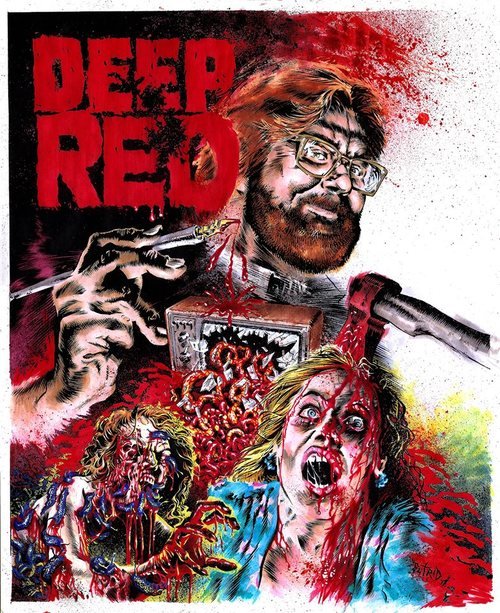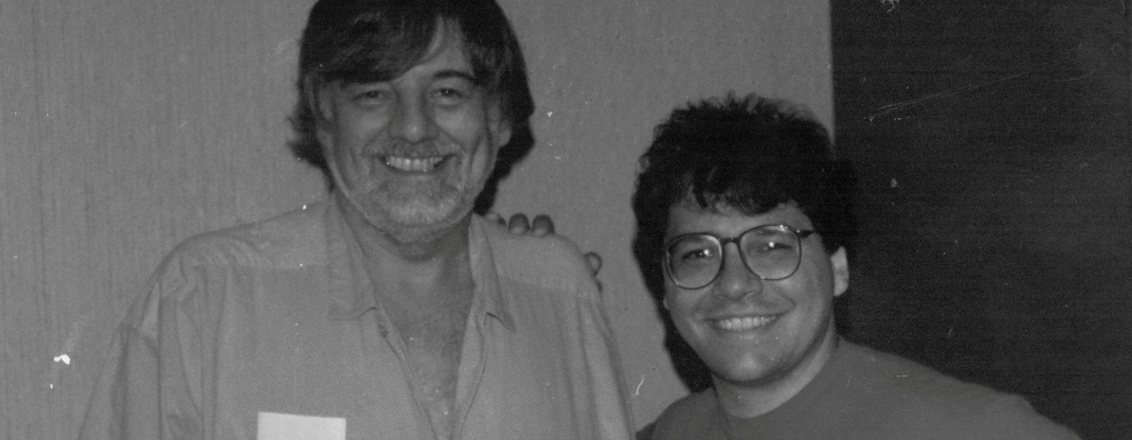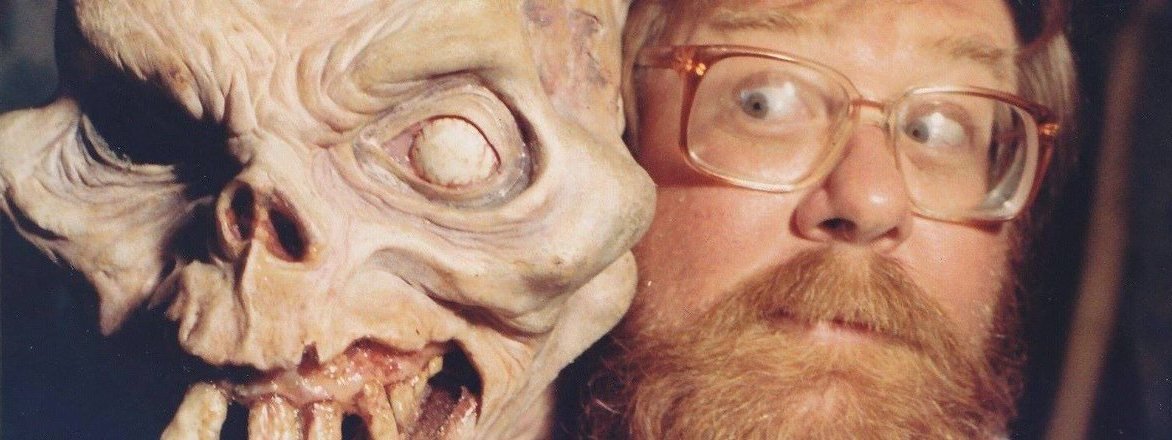DEEP RED VOL. 4, ISSUE #1: Reviving The Righteous And Rowdy In Horror
Back in the day, Fangoria was important to horror fans but it wasn't a struggle to find it. Any halfway decent newsstand or mall bookstore always had it in stock. You knew you were dealing with a true connoisseur if they tracked down a stash of Deep Red.This beloved cult zine was the brainchild of the great, sadly departed Chas Balun, a Fangoria contributor who delved into specialty publishing to create a more rarified vision of horror journalism than studio and ad conscious mainstream horror magazines could pursue. With the help of FantaCo, he got it out to a wider-than-average audience of genre fans and created a dedicated fanbase.Those who were around for the original run of Deep Red know just how important it was to the horror genre's true believers. The late '80s and early '90s were a time when horror got diluted with sequels and comedies. Deep Red offered sustenance during that time, opening up new vistas of horror beyond what was available at the neighborhood theater and introducing its readership to underground and grindhouse versions of horror that would never merit serious ink in another publication. It shined a light in a dark time. Thus, it warmed Schlockmania's horror-loving heart to see Deep Red recently revived by a mixture of alumni and newer kindred spirits under the banner of FantaCo. As this overview of its contents will hopefully illustrate, the debut issue of this new run does a good job of carrying on Balun's celebratory, no-bullshit vision of genre criticism while also referencing issues unique to the current state of horror.The contents of Volume 4, Issue 1 combine interviews and reviews with thoughtpieces on different films and filmmakers. The interviews are a big highlight of the issue. Editor John Szpunar contributes three chats. Cult film fans will be impressed that he landed a chat with Psychotronic guru Michael Weldon. It's the first part of a longer interview and focuses on his formative musical and film influences. It's got a nice relaxed, stream-of-consciousness feel and provides unique insights into the forces that shaped the Psychotronic aesthetic.The other Szpunar pieces are interviews with filmmaker/distributor Stephen Biro and author/horror historian Mike Howlett. The Biro piece is a spirited chat that covers his recent of ultra-gore shockers, including the American revival of Japan's infamous Guinea Pig film series, and it allows him to make a case for his grassroots yet organized and professional approach to filmmaking. The Howlett interview is a delight that focuses on The Weird World Of Eerie Publications, an acclaimed portrait of a notorious line of horror comics from the '70s. It provides a tantalizing taste of what the book covers, like a nice character sketch of oddball publisher Myron Fass, and the way Szpunar and Howlett geek out over their love of obscure horror comics is likely to charm fellow enthusiasts.The other interviews are a chat with Del Howison by returning Deep Red alumnus Kris Gilpin and a talk with exploitation/horror film distributor Lon Kerr from Temple Of Schlock guru Chris Poggiali. Howison owns the popular Burbank horror bookstore Dark Delicacies and he has fun tales to tell about his history with the genre and its various personalities (including Balun). The piece on Kerr is a great deep-dive into the wild west days of indie film distribution in the '70s and '80s. Kerr worked with Motion Picture Marketing so he's got cool stories about films like The Gates Of Hell, Mausoleum and Savage Streets as well as stories about everyone from Steve McQueen to Tom Laughlin!
Thus, it warmed Schlockmania's horror-loving heart to see Deep Red recently revived by a mixture of alumni and newer kindred spirits under the banner of FantaCo. As this overview of its contents will hopefully illustrate, the debut issue of this new run does a good job of carrying on Balun's celebratory, no-bullshit vision of genre criticism while also referencing issues unique to the current state of horror.The contents of Volume 4, Issue 1 combine interviews and reviews with thoughtpieces on different films and filmmakers. The interviews are a big highlight of the issue. Editor John Szpunar contributes three chats. Cult film fans will be impressed that he landed a chat with Psychotronic guru Michael Weldon. It's the first part of a longer interview and focuses on his formative musical and film influences. It's got a nice relaxed, stream-of-consciousness feel and provides unique insights into the forces that shaped the Psychotronic aesthetic.The other Szpunar pieces are interviews with filmmaker/distributor Stephen Biro and author/horror historian Mike Howlett. The Biro piece is a spirited chat that covers his recent of ultra-gore shockers, including the American revival of Japan's infamous Guinea Pig film series, and it allows him to make a case for his grassroots yet organized and professional approach to filmmaking. The Howlett interview is a delight that focuses on The Weird World Of Eerie Publications, an acclaimed portrait of a notorious line of horror comics from the '70s. It provides a tantalizing taste of what the book covers, like a nice character sketch of oddball publisher Myron Fass, and the way Szpunar and Howlett geek out over their love of obscure horror comics is likely to charm fellow enthusiasts.The other interviews are a chat with Del Howison by returning Deep Red alumnus Kris Gilpin and a talk with exploitation/horror film distributor Lon Kerr from Temple Of Schlock guru Chris Poggiali. Howison owns the popular Burbank horror bookstore Dark Delicacies and he has fun tales to tell about his history with the genre and its various personalities (including Balun). The piece on Kerr is a great deep-dive into the wild west days of indie film distribution in the '70s and '80s. Kerr worked with Motion Picture Marketing so he's got cool stories about films like The Gates Of Hell, Mausoleum and Savage Streets as well as stories about everyone from Steve McQueen to Tom Laughlin! Elsewhere, the issue's thoughtpieces offer plentiful macabre points to ponder. Dennis Daniel offers up a triptych of memories about encounters with George Romero that shows how the filmmaker's kindness shaped the direction of his career. Romero is also discussed in an excellent piece by Mike Hunchback that offers a critical but evenhanded assessment of Romero's "second Dead trilogy."There's a theme of nostalgia running through those pieces that continues on in other places: Daniel chimes in sentimental farewells to influential horror magazine artist Basil Gogos and director Tobe Hooper, Nick Cato contributes a nice little piece about his personal history with the fandom ritual of the midnight movie and Shane Dallman reminisces about carrying on the tradition of the t.v. horror host with his character Remo D.However, Deep Red has never been a stranger to speaking out against the phony side of film fandom and the new issue features two stellar pieces in this regard. Greg Goodsell revisits the famous "Unwatchables" piece about bad movies that he wrote for the Deep Red Horror Handbook by looking at the new breed of bad "classics" that manage to actually play at theaters: think Neil Breen, After Last Season, etc. He effectively communicates the mind-melting experience of watching them without lapsing into the smarmy "so bad it's funny, LOL" modern mindset that tries to make failed art into post-modern classics. This piece fits the "challenge to fandom" angle because it makes some interesting points about the negative aspects of bad film culture.The other key piece of rebellion comes from legendary artist and writer Stephen Bissette. It's a 16-page piece that combines memories of his friendship with Chas Balun along with an exploration of the downside of contributing to horror film publications. Both men shared the latter complaint and Bissette unfurls many anecdotes that illustrate the justified reasons they felt this way. You'll see how even fan-beloved scribes get treated poorly at the hands of editors who grow more immature and careless each year: a recent experience Bissette had with a name-brand publication seen at local newsstands is both galling and mordantly funny.A selection of capsule reviews rounds the issue out. These were always fun reads in any Deep Red issue and the tradition continues here. David Zuzelo, no slouch at both indie publications and blogging, does the best job of channeling the rowdy, taboo-trashing yet well-informed gutter wit that defined the best Balun capsule reviews.
Elsewhere, the issue's thoughtpieces offer plentiful macabre points to ponder. Dennis Daniel offers up a triptych of memories about encounters with George Romero that shows how the filmmaker's kindness shaped the direction of his career. Romero is also discussed in an excellent piece by Mike Hunchback that offers a critical but evenhanded assessment of Romero's "second Dead trilogy."There's a theme of nostalgia running through those pieces that continues on in other places: Daniel chimes in sentimental farewells to influential horror magazine artist Basil Gogos and director Tobe Hooper, Nick Cato contributes a nice little piece about his personal history with the fandom ritual of the midnight movie and Shane Dallman reminisces about carrying on the tradition of the t.v. horror host with his character Remo D.However, Deep Red has never been a stranger to speaking out against the phony side of film fandom and the new issue features two stellar pieces in this regard. Greg Goodsell revisits the famous "Unwatchables" piece about bad movies that he wrote for the Deep Red Horror Handbook by looking at the new breed of bad "classics" that manage to actually play at theaters: think Neil Breen, After Last Season, etc. He effectively communicates the mind-melting experience of watching them without lapsing into the smarmy "so bad it's funny, LOL" modern mindset that tries to make failed art into post-modern classics. This piece fits the "challenge to fandom" angle because it makes some interesting points about the negative aspects of bad film culture.The other key piece of rebellion comes from legendary artist and writer Stephen Bissette. It's a 16-page piece that combines memories of his friendship with Chas Balun along with an exploration of the downside of contributing to horror film publications. Both men shared the latter complaint and Bissette unfurls many anecdotes that illustrate the justified reasons they felt this way. You'll see how even fan-beloved scribes get treated poorly at the hands of editors who grow more immature and careless each year: a recent experience Bissette had with a name-brand publication seen at local newsstands is both galling and mordantly funny.A selection of capsule reviews rounds the issue out. These were always fun reads in any Deep Red issue and the tradition continues here. David Zuzelo, no slouch at both indie publications and blogging, does the best job of channeling the rowdy, taboo-trashing yet well-informed gutter wit that defined the best Balun capsule reviews. In short, the return of Deep Red is as triumphant as it heartwarming for all us old-school horror fanatics. Somewhere in horror heaven, Balun is smiling as he draws gruesome art and listens to Blue Cheer. Here's to hoping this revival continues on for another multi-year run. Today's horror scene could use it.You can purchase Deep Red Volume 4, Issue 1 and other fine horror publications by clicking here.
In short, the return of Deep Red is as triumphant as it heartwarming for all us old-school horror fanatics. Somewhere in horror heaven, Balun is smiling as he draws gruesome art and listens to Blue Cheer. Here's to hoping this revival continues on for another multi-year run. Today's horror scene could use it.You can purchase Deep Red Volume 4, Issue 1 and other fine horror publications by clicking here.


